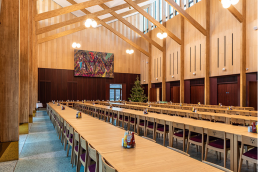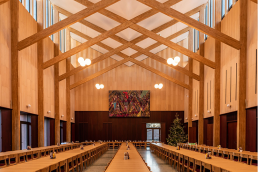This website uses cookies so that we can provide you with the best user experience possible. Cookie information is stored in your browser and performs functions such as recognising you when you return to our website and helping our team to understand which sections of the website you find most interesting and useful.
University of Cambridge’s Dining Hall
ProjectUniversity of Cambridge's Dining HallLocationCambridge, EnglandArchitectFielden Fowles, EnglandInstaller2B Heard / Whitwam AVI , EnglandAcousticianMax Fordham, EnglandSubmitted byK-array USA
For the University of Cambridge’s latest student dining hall, the college’s team installed a series of new equipment to provide its historic walls with a modern refresh. This included: 16 Vyper-KV52 I, four Rumble-KU26, two Kobra-KK52 I, eight Tornado-KT2C, and one Rumble-KU44 I.
The building itself is a remarkable model of sustainability, clever design and engineering ingenuity. It is an all-electric building, passively ventilated during the summer while in colder months heat is recovered from the kitchen cooking hoods and sent back into the hall.
Hot water and heat are provided by ground-source heat pumps installed under the lawn. The K-array system has gone down well with Homerton’s IT team: “The speaker system was put in right at the end of the 24-month build and the installers had to work in the midst of the floor going in and the wall panels going up – there were 100 people doing 100 different jobs in a very small space.
“Our team had training on how to use the system and we took over responsibility from there. The system’s main use is for speeches and a little music background when required. Honestly, we all worried about such small speakers being up to the task, which is why subwoofers were added, but on the first demo the sound output was seriously impressive considering their size.”
Intelligibility could have been an issue given the volume of the 400-capacity dining hall but projection has proven to be excellent. Homerton’s IT manager commented: “We’ve had this room full of people with people chatting at the front – and this is also a testament to the natural acoustics – and you can hear perfectly from wherever you are in the room.
“We genuinely didn’t believe it would sound as good as it does based on the small amount of equipment, and that has also pleased the architects who are very keen for hardware to be unobtrusive. We’re pleased at how well the speakers blend in with the surroundings and how much sound they produce considering the size they are. In terms of feedback from staff and students, if there’s ever a problem we are going to hear about it – but there hasn’t been a word, no complaints whatsoever. We’re very happy with the result.”




